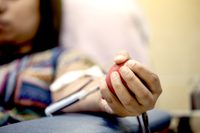Lindsey Keill, MLS(ASCP)CMSBB; Stacie Lansink, MS, MT(ASCP); April Nelson, MLS(ASCP)CM; Tiffany Montalvo, MLS(ASCP)CM
A 22-year-old female presented to the blood bank to donate blood. A type and screen were performed. The donor typed as B-positive with a positive antibody screen. The autocontrol was negative, which assisted in ruling out the possibility of a warm autoantibody. The technologist noted the strength of the reactions to be like that of a patient with multiple antibodies. Usually these individuals have varying strengths of reactivity on a panel or antibody screen, whereas high frequency antibodies tend to have more of a uniform pattern of reactivity.
The technologist tested additional panel cells to determine if any clinically-significant antibodies could be ruled out. The reactions were still positive. The technologist performed an enzyme panel; those results were all positive. The technologist then checked the donor ethnicity to determine if a high incidence antibody was a possibility. Certain high-frequency antibodies are more common in certain ethnic groups, such as Anti-Fy3, Anti-Hrb, Anti-Jsb, and Anti-U in African Americans, and Anti-VEL and anti-Kpb in Caucasians. The donor was registered as being of Asian descent.
There was no indication on the donor questionnaire of being recently transfused. The technologist phenotyped the patient and received the following results:
| E | C | K | Fya | S | Jka | Jkb |
| 0 | 0 | 0 | 0 | 0 | 0 | 0 |
Based on the negative results for Jka and Jkb, the technologist believed the donor may have developed Anti-Jk3. The blood bank had an inventory of rare frozen red cell droplets that can be thawed in cases like this to either assist in ruling out or confirming a high-frequency antibody. The technologist removed two Jk3 negative cells from frozen inventory and tested those cells with the patient’s plasma. Both cells were negative. This confirmed the Anti-JK3. The technologist still needed to rule out any underlying clinically significant antibodies, so rather than deplete the inventory of rare frozen red cells, the technologist chose to adsorb out the JK3 and test the adsorbed serum against fresh panel cells to rule out any other antibodies. Since 99.9% of people are JK3 positive, it was an easy procedure to incubate the serum with another donor’s red cells and pull the Anti-JK3 out of the donor’s serum. The technologist performed the adsorption and the antibody screen was negative; thus, ruling out any other clinically significant antibodies.
Anti-Jk3 is a high-frequency antibody in the Kidd system. It commonly forms in patients that phenotype as Jk(ab)-. There are two ways this can occur. One is that the donor is homozygous JkJk and genotypes Jk(ab)-, making them a true null phenotype. The other possible mechanism is a silencing mutation that can occur. The donor may have inherited any combination of Kidd alleles but there is a genetic mutation that prevents the alleles from being expressed giving the appearance of Jk(ab)- phenotype but genotyping as having functioning Kidd alleles. It is like the GATA box mutation in the Duffy system that causes many people of African descent to phenotype at Fy(ab)-. If the donor/patient types negative for the Jka and Jkb antigens, they can form what is known as an Anti-JK3. It will react with all cells that are not Jka- and Jkb-. This rare phenotype is found in >99.9% of the population. However, there are certain ethnic groups in which the JK(ab)- phenotype is more common. It is seen mostly in Asian populations, particular those of Polynesian or Hawaiian descent.
In summary, this donor presented with a positive antibody screen. The technologist was unable to rule out clinically significant antibodies. Based on the donor’s history and antibody identification panel, the technologist performed an adsorption to rule out other clinically significant antibodies, while ruling in Anti-JK3. This was a typical presentation of a patient with Anti-JK3.

